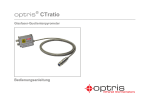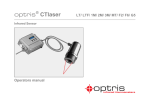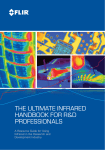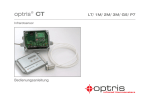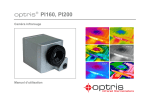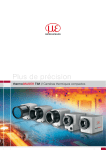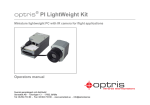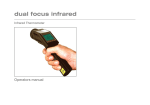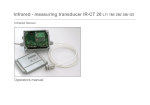Download Bedienungsanleitung, Manuel, Operators manual optris CTratio
Transcript
optris® CTratio ¯¯¯¯¯¯¯¯¯¯¯¯¯¯¯¯¯¯¯¯¯¯¯¯¯¯¯¯¯¯¯¯¯¯¯¯¯¯¯¯¯¯¯¯¯¯¯¯¯¯¯¯¯¯¯¯¯¯¯¯¯¯¯¯¯¯¯¯¯¯¯¯¯¯¯¯¯¯¯¯¯¯¯¯¯¯¯¯¯¯¯¯¯¯¯¯¯¯¯¯¯¯¯¯¯¯¯¯¯¯¯¯¯¯¯¯¯¯¯¯¯¯¯¯¯¯¯¯¯¯¯¯¯¯¯¯¯¯¯¯¯¯¯¯¯¯¯¯¯¯¯¯¯¯¯¯¯¯¯¯¯¯¯¯¯¯¯¯¯¯¯¯¯¯¯¯¯¯¯¯¯¯¯¯¯¯¯¯¯¯¯¯¯¯¯¯¯¯¯¯¯¯¯¯¯¯¯¯¯¯¯¯¯¯¯¯¯¯¯¯ Fiber Optics Ratio Thermometer Operators manual MTS Messtechnik Schaffhausen GmbH Mühlenstrasse 4 , CH - 8260 Stein am Rhein Telefon + 41 52-672 50 00 Telefax + 41 52-672 50 01 www.mts.ch, e-mail: info @ mts.ch Messen Prüfen Automatisieren www.mts.ch CE-Conformity The product complies with the following standards: EMC: Safety: Laser Safety: EN 61326-1:2006 (Basic requirements) EN 61326-2-3:2006 EN 61010-1:2001 EN 60825-1:2007 The product accomplishes the requirements of the EMC Directive 2004/108/EG and of the Low Voltage Directive 2006/95/EG. References to other chapters are marked as: ►. Warranty Each single product passes through a quality process. Nevertheless, if failures occur please contact the customer service at once. The warranty period covers 24 months starting on the delivery date. After the warranty is expired the manufacturer guarantees additional 6 months warranty for all repaired or substituted product components. Warranty does not apply to damages, which result from misuse or neglect. The warranty also expires if you open the product. The manufacturer is not liable for consequential damage or in case of a non-intended use of the product. If a failure occurs during the warranty period the product will be replaced, calibrated or repaired without further charges. The freight costs will be paid by the sender. The manufacturer reserves the right to exchange components of the product instead of repairing it. If the failure results from misuse or neglect the user has to pay for the repair. In that case you may ask for a cost estimate beforehand. optris CTratio – E2013-04-A 1 Content Page Description Scope of Supply Maintenance Safety Note Cautions Factory Default Settings Technical Data General Specifications Electrical Specifications Measurement Specifications Optics Mechanical Installation Accessories Laser Sighting Electrical Installation Cable Connections Ground Connection Outputs and Inputs Analog Output Digital I/O pins Programming Interface Relay Outputs Alarms 2 3 4 4 5 5 6 7 7 8 9 10 13 15 17 18 18 20 21 21 22 23 24 25 Page Operating Sensor Setup Software CompactConnect Installation Communication Settings Basics of Infrared Thermometry The Ratio Principle Emissivity Definition Determination of unknown Emissivities Characteristic Emissivities Characteristic Slope Values Determination of unknown Slope values Attenuation Appendix A – Emissivity Table Metals Appendix B – Emissivity Table Non Metals Appendix C – Smart Averaging optris CTratio – E2013-04-A 26 26 32 32 33 34 35 38 38 38 39 40 40 40 42 44 45 Description The sensors of the optris CTratio series are noncontact infrared temperature sensors. They calculate the surface temperature based on the emitted infrared energy of objects. The CTratio can work in the 1-color-mode as well as in the ratio- or 2-color-mode [► Basics of Infrared Thermometry]. The optical sensing head of the CTratio is made of stainless steel (IP65/ NEMA-4 rating) and is connected via a rugged fiber optics, which is protected by a stainless steel armour, with the sensor electronics (die casting zinc box). 1-color-mode [1C] The 1-color-mode is best for measuring the temperature of objects in areas where no sighting obstructions (solid, gases or dust) exist. The measurement object must fill completely the measurement spot, if the 1color-mode is used. 2-color-mode [2C] In this mode the object temperature will be determined from the ratio of the signal of two separate and overlapping infrared bands. The 2-color-mode is best for measuring the temperature of objects which are partially obscured by other objects, openings or viewing windows that reduce energy and by dirt, smoke or steam in the atmosphere. Another benefit of the 2-color-mode is that the measurement object can be smaller than the measurement spot, provided the background is cooler than the target [► The Ratio Principle]. optris CTratio – E2013-04-A 3 The CTratio sensing head is a sensitive optical system. Please use only the thread for mechanical installation. Avoid mechanical violence on the head – this may destroy the system (expiry of warranty). Scope of Supply CTratio sensing head with fibre connection cable and electronic box 2 mounting nuts Mounting bracket, adjustable in one axis Operators manual Maintenance Lens cleaning: Blow off loose particles using clean compressed air. The lens surface can be cleaned with a soft, humid tissue moistened with water or a water based glass cleaner. 4 PLEASE NOTE: Never use cleaning compounds which contain solvents (neither for the lens nor for the housing). optris CTratio – E2013-04-A Safety Note WARNING! This sensor contains an internal HIGH POWER LASER which is used for spot size illumination via the fiber optics cable. Before you open the electronics, remove the fiber optical cable from the electronics or disassemble the optical head the sensor must be switched off and disconnected from the power supply and USB interface! The laser power at properly usage of the sensor (fiber optical cable incl. sensing head connected) is < 1mW and fulfils laser class 2 according IEC 60825-1:2007. Cautions Avoid static electricity. The fiber optical cable has a minimum bending radius of 40 mm. In case of problems or questions which may arise when you use the CTratio, please contact our service department. Read the manual carefully before the initial start-up. The producer reserves the right to change the herein described specifications in case of technical advance of the product. optris CTratio – E2013-04-A 5 Factory Default Settings The unit has the following presetting at time of delivery: Signal output object temperature Emissivity Slope Averaging (AVG) Smart Averaging Peak hold Valley hold Output channel 1 Lower limit temperature range [°C] Upper limit temperature range [°C] Lower limit signal output Upper limit signal output Max. attenuation Temperature unit Baud rate [kBaud] 6 0-5 V 1,000 1,000 inactive inactive inactive inactive T 2C (2C temperature) 700 1800 0V 5V 95 % °C 115 optris CTratio – E2013-04-A Smart Averaging means a dynamic average adaptation at high signal edges [activation via software only]. ► Appendix C Technical Data General Specifications Sensing head Electronic box Environmental rating Ambient Temperature Storage temperature Relative humidity IP65 (NEMA-4) -20...250 °C -40...250 °C 10...95%, non condensing IP65 (NEMA-4) 0...85 °C (70 °C with Laser ON) -40...85 °C 10...95%, non condensing Material Dimensions die casting zinc 89 mm x 70 mm x 30 mm Weight stainless steel length: 78,1 mm (SF head) 82,6 mm (CF head) thread: M18x1 375 g (incl. fiber optics 3 m) Fiber optics Fiber optics length multimode fiber, stainless steel armour 3 m (standard), 6 m, 10 m, 15 m, 22 m Vibration Shock IEC 68-2-6: 3G, 11 – 200Hz, any axis IEC 68-2-27: 50G, 11ms, any axis Software CompactConnect (optional; for programming only) optris CTratio – E2013-04-A 420 g 7 Electrical Specifications Power Supply Current draw Aiming laser 8–36 VDC max. 200 mA 650 nm, 1mW, On/ Off via programming keys or software Outputs/ analog selectable: 0/ 4–20 mA, 0–5/ 10 V Digital I/O pins 2 programmable in-/ outputs, usable as: Alarm output (open collector output [24 V/ 1 A]) Digital input for triggered signal output and peak hold function Output impedances mA mV max. loop resistance 500 Ω (at 8-36 VDC) min. 100 KΩ load impedance Digital interface USB (optional; for programming only) Relay outputs 2 x 60 VDC/ 42 VACRMS, 0,4 A; optically isolated (optional plug-in module) 8 optris CTratio – E2013-04-A Measurement Specifications Temperature range (scalable) Spectral range Optical resolution 1) 700...1800 °C 0,7...1,1 µm 40:1 (SF optics) 40:1 (CF2 optics) 2) System accuracy 1) Repeatability Temperature resolution (>900 °C) Response time (95 % signal) ±(0,5 % of reading +1 °C) 2) ±(0,1 % of reading +1 °C) 0,1 K 3) 5 ms...10 s Emissivity Slope Signal processing 0,050...1,000 (adjustable via programming keys or analog input) 0,800...1,200 (adjustable via programming keys or analog input) One-color-, Two-color-mode, Attenuation monitoring, Alarm, Average, Peak hold, Valley hold, Advanced peak hold with threshold and hysteresis (adjustable via programming keys or software) 1) at ambient temperature 235 °C = 1/ Response time 1s 3) with dynamic adaptation at low signal levels 2) optris CTratio – E2013-04-A 9 Optics The CTratio is available in two focus versions: SF optics: CF2 optics: 41 mm@ 1524 mm (D:S = 40:1) 7,7 mm@ 305 mm (D:S = 40:1) The following optical charts show the diameter of the measuring spot in dependence on the distance between measuring object and sensing head. The spot size refers to 95 % of the radiation energy. The distance is always measured from the front edge of the sensing head. SF optics 10 optris CTratio – E2013-04-A CF2 optics distance = distance from front edge of the sensing head to the measurement object The D:S ratio is valid for the focus point. optris CTratio – E2013-04-A 11 Sensor placement [1C mode] The size of the measuring object and the optical resolution of the infrared thermometer determine the maximum distance between sensing head and measuring object. In order to prevent measuring errors the object should fill out the field of view of the optics completely. Consequently, the spot should at all times have at least the same size like the object or should be smaller than that. Sensor placement [2C mode] In the 2-color-mode the sensing head can be placed under various conditions, like: Measurement through holes smaller than the spot size Measurement through dust, smoke or steam in the atmosphere Measurement of objects smaller than the measurement spot Measurement through a dirty lens or dirty sighting window [► The Ratio Principle] Please note that the sensor accuracy is not guaranteed for signal reductions of more than 95%. 12 optris CTratio – E2013-04-A Mechanical Installation The CTratio sensing heads are equipped with a metrical M18x1-thread and can be installed either directly via the sensor thread or with help of the hex nuts (2 pieces included in scope of supply) to the mounting bracket available. Various mounting brackets, which make the adjustment of the sensing head easier, can be additionally ordered as accessories. Sensing head Please make sure that the minimum bending radius of the fiber optics of 40 mm will be considered during installation. optris CTratio – E2013-04-A 13 Electronic box The electronic box is also available with closed cover (display and programming keys with no access from outside) [ACCTCOV]. 14 optris CTratio – E2013-04-A Accessories Mounting bracket, adjustable in one axis [ACCTFBMH] Air purge collar [ACCTAPMH] The lens must be kept clean at all times from dust, smoke, fumes and other contaminants in order to avoid reading errors (in the 1-color-mode). These effects can be reduced by using an air purge collar. Make sure to use oil-free, technically clean air, only. The needed amount of air (approx. 2...10 l/ min.) depends on the application and the installation conditions on-site. optris CTratio – E2013-04-A 15 Rail Mount Adapter for Electronic box With the rail mount adapter the CTratio electronics can be mounted easily on a DIN rail (TS35) according EN50022. ACCTRAIL 16 optris CTratio – E2013-04-A Laser Sighting The integrated laser sighting supports the alignment and focusing of the optics. The size of the laser dot is equal to the real measurement spot size at any distance. If the laser is activated the temperature measurement is not possible! The laser can be activated/ deactivated via the programming keys on the unit or via the software. If the laser is activated a yellow LED will shine (beside temperature display). [► Electrical Installation/ Operating] At ambient temperatures >70 °C on the electronic box the laser will switch off automatically. WARNING: Do not point the laser directly at the eyes of persons or animals! Do not stare into the laser beam. Avoid indirect exposure via reflective surfaces! WARNING: Inside the electronic box a HIGH POWER LASER is located. The laser light is coupled into the fiber optics. On the outlet at the optical head the laser power is < 1mW and fulfils laser class 2 according IEC 60825-1:2007. Before you open the box, remove the fiber optical cable from the electronics or disassemble the optical head the sensor must be switched off and disconnected from the power supply and USB interface! SAFETY SWITCH: If the fiber optical cable will be removed from the electronics the laser will be switched off automatically. Any manipulation at this safety switch is prohibited. optris CTratio – E2013-04-A 17 Electrical Installation Cable Connections For the electrical installation of the CTratio please open at first the cover of the electronic box (4 screws). Below the display are the screw terminals for the cable connection. Designation +8..36VDC GND GND I/O 2 I/O 1 OUT-mV/mA Power supply Ground (0V) of power supply Ground (0V) of in- and outputs I/O pin 2 (digital In- /Output or analog input) I/O pin 1 (digital In-/ Output or analog input) Analog output object temperature (mV or mA) CAUTION: Please do never connect a supply voltage to the analog outputs as this will destroy the output! The CTratio is not a 2-wire sensor! Power supply Opened electronic box with terminal connections Please use a power supply unit with an output voltage of 8–36 VDC which can supply 200 mA. The ripple should be max. 200 mV. 18 optris CTratio – E2013-04-A Cable Assembling The cable gland M12x1,5 allows the use of cables with a diameter of 3 to 5 mm. Remove the isolation from the cable (40 mm power supply, 50 mm signal outputs, 60 mm functional inputs). Cut the shield down to approximately 5 mm and spread the strands out. Extract about 4 mm of the wire isolation and tin the wire ends. Place the pressing screw, the rubber washer and the metal washers of the cable gland one after the other onto the prepared cable end. Spread the strands and fix the shield between two of the metal washers. Insert the cable into the cable gland until the limit stop. Screw the cap tight. Every single wire may be connected to the according screw clamps according to their colors. Use shielded cables only. The sensor shield has to be grounded. optris CTratio – E2013-04-A 19 Ground Connection On the mainboard PCB you will find a black wire which is connecting factory-default the ground connections (GND power supply/ outputs) with the ground of the electronics housing. To avoid ground loops and related signal interferences in industrial environments it might be necessary to interrupt this connection. 20 optris CTratio – E2013-04-A Outputs and Inputs The CTratio has an analog output and two digital I/O pins (programmable as in- or output). Analog Output The selection of the signal on output channel 1 can be done via the programming keys [► Operating]. The following output signals can be selected: 0-5 V 0-10 V 0-20 mA 4-20 mA CAUTION: Please do never connect a supply voltage to the analog outputs as this will destroy the output. The CTratio is not a 2-wire sensor! The following signal sources can be selected for output channel 1: T 2C T 1C Attenuation 2C temperature 1C temperature Signal attenuation in % optris CTratio – E2013-04-A 21 I/O pins The CTratio has two digital pins which can be programmed as outputs (digital) or as inputs (digital or analog) using the CompactConnect software. The following functions are available: Function Digital Alarm I/O pin acts as output digital Valid LO input digital Valid HI input digital Hold ‗/¯ input digital Hold ¯\‗ input digital Slope external input analog Emiss. external input analog High level: Low level: 22 Description Open collector output/ definition as HIGH- or LOW alarm via norm. open/ norm. close options in software dialog. The output follows the object temperature as long as there is a Low level at the I/O pin. After discontinuation of the Low level the last value will be held. The output follows the object temperature as long as there is a High level at the I/O pin. After discontinuation of the High level the last value will be held. The last value will be held if there is a signal with a rising edge on the I/O pin. The last value will be held if there is a signal with a falling edge on the I/O pin. The slope value can be adjusted via a 0-10 V signal on the I/O pin (scaling possible via software). The emissivity value can be adjusted via a 0-10 V signal on the I/O pin (scaling possible via software). 0,8 V 0,8 V optris CTratio – E2013-04-A Programming Interface CTratio sensors can be optionally equipped with an USB-interface for programming of the sensor. If you want to install the interface, plug the interface board into the place provided, which is located beside the display. In the correct position the holes of the interface match with the thread holes of the electronic box. Now press the board down to connect it and use both M3x5 screws for fixing it. Plug the preassembled interface cable with the terminal block into the male connector of the interface board. If the USB interface is used the sensor is powered by the computer. If you use the laser and/ or display backlight we recommend an additional power supply. The usage of the USB interface is only recommended for programming purposes of the sensor. A continuous operation with interface is not permitted! Please pay attention to the notes in the according interface manuals. optris CTratio – E2013-04-A 23 Relay Outputs The CTratio can be optionally equipped with a relay output. The relay board will be installed the same way as the programming interface. A simultaneous installation of the programming interface and the relay outputs is not possible. The relay board provides two fully isolated switches, which have the capability to switch max. 60 VDC/ 42 VACRMS, 0,4 A DC/AC. A red LED shows the closed switch. The switching thresholds are in accordance with the values for the visual alarms (LCD backlight). To set the alarm values the digital programming interface (USB) and the software is needed. 24 optris CTratio – E2013-04-A Alarms The CTratio has the following Alarm features: All alarms have a fixed hysteresis of 2 K. Visual Alarms These alarms will cause a change of the color of the LCD display and will also change the status of the optional relays interface. Digital Alarm 1 and 2 Both of the I/O pins can be programmed as alarm output. In this case the pin acts as an open collector output (24 V/ 1A). The following signal sources can be selected: T 2C/ T 1C/ Attenuation/ TBox/ TProcess (Temperature signal which has been selected for the analog output) For a setup of the alarm values, selection of the signal sources and definition as high or low alarm (via change of normally open/ closed) the programming interface (USB) including the software is needed. Different wirings of the open collector output optris CTratio – E2013-04-A 25 Operating After power up the unit the sensor starts an initializing routine for some seconds. During this time the display will show INIT. After this procedure the object temperature is shown in the display. The display backlight color changes according to the alarm settings [► Alarms/ Visual Alarms]. Sensor Setup The programming keys Mode, Up and Down enable the user to set the sensor on-site. The current measuring value or the chosen feature is displayed. With Mode the operator obtains the chosen feature, with Up and Down the functional parameters can be selected – a change of parameters will have immediate effect. If no key is pressed for more than 10 seconds the display automatically shows the calculated object temperature (according to the signal processing). Pressing the Mode button again recalls the last called function on the display. The signal processing features Peak hold and Valley hold cannot be selected simultaneously. Factory Default Setting To set the CTratio back to the factory default settings, please press at first the Down-key and then the Mode-key and keep both pressed for approx. 3 seconds. The display will show RESET for confirmation. 26 optris CTratio – E2013-04-A Display Mode [Sample] Adjustment Range S ON 700.0 || 600.0 | 65.0 % 23.3 CB MV5 Laser Sighting [On] Current 2C temperature [700,0 °C] Current 1C temperature [600,0 °C] Current attenuation [65,0 %] Box temperature [23,3 °C] Signal output channel 1 [0-5 V] R 1.000 E 0.970 D 95.0 MD 2C Slope [1,000] Emissivity [0,970] Max. attenuation [95,0 %] Main display (on electronic box) [2C temperature value] A 0.2 P---V---u 700.0 n 1500 [ 0.00 ] 5.00 U °C M 01 B 115 Signal output Average [0,2 s] Signal output Peak hold [inactive] Signal output Valley hold [inactive] Lower limit temperature range [700 °C] Upper limit temperature range [1500 °C] Lower limit signal output [0 V] Upper limit signal output [5 V] Temperature unit [°C] Multidrop adress [1] (only with RS485 interface) Baud rate in kBaud [115] ON/ OFF fixed fixed fixed fixed 0-20 = 0–20 mA/ 4-20 = 4–20 mA/ MV5 = 0–5 V/ MV10 = 0-10 V 0,800 ... 1,200 0,050 ... 1,000 -50,0 ... 99,0 2C = 2C temperature/ 1C = 1C temperature/ AT = attenuation A---- = inactive/ 0,1 … 999,9 s P---- = inactive/ 0,1 … 999,9 s/ P oo oo oo oo = infinite V---- = inactive/ 0,1 … 999,9 s/ V oo oo oo oo = infinite depending on model depending on model according to the range of the selected output signal according to the range of the selected output signal °C/ °F 01 … 32 9,6/ 19,2/ 38,4/ 57,6/ 115,2 kBaud optris CTratio – E2013-04-A 27 S ON Activating (ON) and Deactivating (OFF) of the integrated Sighting Laser By pressing Up or Down the laser will be switched on or off. If the laser is activated a measurement cannot be done. MV5 Selection of the Output signal. By pressing Up or Down the different output signals can be selected [► Outputs and Inputs]. R 1.000 Setup of Slope. Pressing Up increases the value, Down decreases the value (also valid for all further functions). The slope is the quotient of the emissivities of both of the overlapping wavelengths and therewith the deciding parameter for measurements in 2-color mode. [► Characteristic Slope Values] E 0.970 Setup of Emissivity. The emissivity is a material constant factor to describe the ability of the body to emit infrared energy. The emissivity only affects measurements in the 1-color mode. [► Emissivity] D 95.0 Setup of the allowed Attenuation. The temperature measurement will stop if the attenuation exceeds this limit [► Attenuation]. MD 2C Setup of the Main display on the electronic box. By pressing Up or Down you can select if the 2C temperature, 1C temperature or attenuation should be displayed (independent from the selected output signal). A 0.2 Setup of Average time. If the value is set to 0.0 the display will show --- (function deactivated). In this mode an arithmetic algorithm will be performed to smoothen the signal. The set time is the time constant. This function can be combined with all other post processing functions. 28 optris CTratio – E2013-04-A P---- Setup of Peak hold. If the value is set to 0.0 the display will show --- (function deactivated). In this mode the sensor is waiting for descending signals. If the signal descends the algorithm maintains the previous signal peak for the specified time. After the hold time the signal will drop down to the second highest value or will descend by 1/8 of the difference between the previous peak and the minimum value during the hold time. This value will be held again for the specified time. After this the signal will drop down with slow time constant and will follow the current object temperature. V---- Setup of Valley hold. If the value is set to 0.0 the display will show --- (function deactivated). In this mode the sensor waits for ascending signals. The definition of the algorithm is according to the peak hold algorithm (inverted). u 700.0 Setup of the Lower limit of temperature range. The minimum difference between lower and upper limit is 20 K. If you set the lower limit to a value ≥ upper limit the upper limit will be adjusted to [lower limit + 20 K] automatically. n 1800 Setup of the Upper limit of the temperature range. The minimum difference between upper and lower limit is 20 K. The upper limit can only be set to a value = lower limit + 20 K. [ 0.00 Setup of the Lower limit of the signal output. This setting allows an assignment of a certain signal output level to the lower limit of the temperature range. The adjustment range corresponds to the selected output mode (e.g. 0-5 V). ] 5.00 Setup of the Upper limit of the signal output. This setting allows an assignment of a certain signal output level to the upper limit of the temperature range. The adjustment range corresponds to the selected output mode (e.g. 0-5 V). optris CTratio – E2013-04-A 29 Signal graph with P---- ▬ TProcess with Peak Hold (Hold time = 1s) ▬ TActual without post processing 30 optris CTratio – E2013-04-A U °C Setup of the Temperature unit [°C or °F]. M 01 Setup of the Multidrop address. In a RS485 network each sensor will need a specific address. This menu item will only be shown if a RS485 interface board is plugged in. B 115k Setup of the Baud rate for digital data transfer. optris CTratio – E2013-04-A 31 Software CompactConnect Installation Insert the installation CD into the according drive on your computer. If the autorun option is activated the installation wizard will start automatically. Otherwise please start CDsetup.exe from the CDROM. Follow the instructions of the wizard until the installation is finished. Min. system requirements: Windows XP, Vista, 7 USB interface Hard disc with at least 30 MByte free space At least 128 MByte RAM CD-ROM drive The installation wizard will place a launch icon on the desktop and in the start menu: [Start]\Programs\CompactConnect. If you want to uninstall the software from your system please use the uninstall icon in the start menu. You will find a detailed software manual on the CD. Main Features: Complete sensor setup Adjustment of signal processing functions Programming of outputs and functional inputs 32 optris CTratio – E2013-04-A Communication Settings Serial Interface Baud rate: Data bits: Parity: Stop bits: Flow control: 9,6...115,2 kBaud (adjustable on the unit or via software) 8 none 1 off Protocol All sensors of the CTratio series are using a binary protocol. optris CTratio – E2013-04-A 33 Basics of Infrared Thermometry Depending on the temperature each object emits a certain amount of infrared radiation. A change in the temperature of the object is accompanied by a change in the intensity of the radiation. For the measurement of “thermal radiation” infrared thermometry uses a wave-length ranging between 1 µ and 20 µm. The intensity of the emitted radiation depends on the material. This material contingent constant is described with the help of the emissivity which is a known value for most materials (see enclosed table emissivity). Infrared thermometers are optoelectronic sensors. They calculate the surface temperature on the basis of the emitted infrared radiation from an object. The most important feature of infrared thermometers is that they enable the user to measure objects contactless. Consequently, these products help to measure the temperature of inaccessible or moving objects without difficulties. Infrared thermometers basically consist of the following components: lens spectral filter detector electronics (amplifier/ linearization/ signal processing) The specifications of the lens decisively determine the optical path of the infrared thermometer, which is characterized by the ratio Distance to Spot size. The spectral filter selects the wavelength range, which is relevant for the temperature measurement. The detector in cooperation with the processing electronics transforms the emitted infrared radiation into electrical signals. 34 optris CTratio – E2013-04-A The Ratio Principle The 2-color ratio technology makes possible accurate and repeatable temperature measurements that are free from dependence on absolute radiated energy values. In use, a 2-color sensor determines temperature from the ratio of the radiated energies in two separate wavelength bands (colors). The benefits of 2-color sensors are that accurate measurements can be made under the following conditions: ► ► ► When the field of view to the target is partially blocked or obscured. When the target is smaller than the sensor’s field of view. When target emissivities are low or changing by the same factor in both wavelength bands. Another benefit is that 2-color sensors measure closer to the highest temperature within the measured spot (spatial peak picking) instead of an average temperature. A 2-color sensor can be mounted farther away, even if the target does not fill the resulting spot size. The convenience is that you are not forced to install the sensor at some specific distance based upon target size and the sensor’s optical resolution. Partially Obscured Targets The radiated energy from a target is, in most cases, equally reduced when objects or atmospheric materials block some portion of the optical field of view. It follows that the ratio of the energies is unaffected, and thus the measured temperatures remain accurate. A 2-color sensor is better than a 1-color sensor in the following conditions: ► ► ► Sighting paths are partially blocked (either intermittently or permanently). Dirt, smoke, or steam is in the atmosphere between the sensor and target. Measurements are made through items or areas that reduce emitted energy, such as grills, screens, channels or small openings optris CTratio – E2013-04-A 35 ► ► Measurements are made through a viewing window that has unpredictable and changing infrared transmission due to accumulating dirt and/or moisture on the window surface. The sensor itself is subject to dirt and/or moisture accumulating on the lens surface. 1-color sensors see polluted atmosphere and dirty windows and lenses as a reduction in energy and give much lower than actual temperature readings. Targets Smaller Than Field of View When a target is not large enough to fill the field of view, or if the target is moving within the field of view, radiated energies are equally reduced, but the ratio of the energies is unaffected and measured temperatures remain accurate. This remains true as long as the background temperature is much lower than the target temperature. Example: ► Measuring of wire or rod — often too narrow for field of view or moving or vibrating unpredictably. It is much easier to obtain accurate results because sighting is less critical with 2-color sensors. Low or Changing Emissivities If the emissivities in both wavelengths (colors) were the same, as they would be for any blackbody (emissivity = 1.0) or greybody (emissivity < 1.0 but constant), then their ratio would be 1, and target emissivity would not be an influence. However, in nature there is no such thing as a greybody. The emissivity of all real objects changes with wavelength and temperature, at varying degrees, depending on the material. 36 optris CTratio – E2013-04-A When emissivity is uncertain or changing, a 2-color sensor can be more accurate than a 1-color instrument as long as the emissivity changes by the same factor in both wavelength bands. Note, however, that accurate measurement results are dependent on the application and the type of material being measured. To determine how to use 2-color sensors with your application when uncertain or changing emissivities are a factor, please contact your sales representative. optris CTratio – E2013-04-A 37 Emissivity Definition The intensity of infrared radiation, which is emitted by each body, depends on the temperature as well as on the radiation features of the surface material of the measuring object. The emissivity (ε – Epsilon) is used as a material constant factor to describe the ability of the body to emit infrared energy. It can range between 0 and 100 %. A “blackbody” is the ideal radiation source with an emissivity of 1,0 whereas a mirror shows an emissivity of 0,1. If the emissivity chosen is too high, the infrared thermometer may display a temperature value which is much lower than the real temperature – assuming the measuring object is warmer than its surroundings. A low emissivity (reflective surfaces) carries the risk of inaccurate measuring results by interfering infrared radiation emitted by background objects (flames, heating systems, chamottes). To minimize measuring errors in such cases, the handling should be performed very carefully and the unit should be protected against reflecting radiation sources. Determination of unknown Emissivities ► First, determine the actual temperature of the measuring object with a thermocouple or contact sensor. Second, measure the temperature with the infrared thermometer and modify the emissivity until the displayed result corresponds to the actual temperature. ► If you monitor temperatures of up to 380°C you may place a special plastic sticker (emissivity dots – part number: ACLSED) onto the measuring object, which covers it completely. Now set the emissivity to 0,95 and take the temperature of the sticker. Afterwards, determine the temperature of the adjacent area on the measuring object and adjust the emissivity according to the value of the temperature of the sticker. 38 optris CTratio – E2013-04-A ► Cove a part of the surface of the measuring object with a black, flat paint with an emissivity of 0,98. Adjust the emissivity of your infrared thermometer to 0,98 and take the temperature of the colored surface. Afterwards, determine the temperature of a directly adjacent area and modify the emissivity until the measured value corresponds to the temperature of the colored surface. CAUTION: On all three methods the object temperature must be different from ambient temperature. Characteristic Emissivities In case none of the methods mentioned above help to determine the emissivity you may use the emissivity tables ►Appendix A and B. These are average values, only. The actual emissivity of a material depends on the following factors: temperature measuring angle geometry of the surface thickness of the material constitution of the surface (polished, oxidized, rough, sandblast) spectral range of the measurement transmissivity (e.g. with thin films) optris CTratio – E2013-04-A 39 Characteristic Slope Values The slope is the quotient of the emissivities of both of the overlapping wavelength bands. The factory default value for the slope is 1,000. The following slopes are typical reference values. The real slope can vary depending on the metal alloy and surface finish. Cobalt, Iron, Nickel, Stainless steel, Steel ► oxidized surfaces Slope: 1,000 Cobalt, Iron (solid, molten), Molybdenum, Nickel, Platinum, Rhodium, Stainless steel, Steel, Tantalum, Tungsten, Wolfram ► unoxidized surfaces Slope: 1,060 Determination of unknown Slope values Basically you can use the same methods to determine an unknown slope as described under ► Determination of unknown Emissivities. As the CTratio is dedicated for high temperature applications, only the first method may be practically applicable (use of a t/c or other contact probe). Attenuation The CTratio is able to measure the temperature of targets smaller than the field of view (FOV). If the target size is smaller than the FOV (and thus attenuating the signal) this may cause a small inaccuracy of the reading. The inaccuracy is dependent on the object temperature and value of attenuation. The higher the object temperature and attenuation the higher the inaccuracy of the sensor. 40 optris CTratio – E2013-04-A This figure is showing the typical temperature reading of a ratio thermometer optris CT ratio in both the 1color- and the 2-color-mode in addiction of increasing contamination of the optical transmission path inbetween the target and the ratio thermometer. Due to the ratio principle the 2 channel signal (upper curve) stays very stable over a wide range of attenuation up to over 90%. The signal of the 1 channel mode (lower curve), acting like in a standard pyrometer with one measuring wavelength only, is decreasing rapidly with the contamination of the transmission path. optris CTratio – E2013-04-A 41 Appendix A – Emissivity Table Metals Material Aluminium Brass Copper Spectral response non oxidized polished roughened oxidized polished roughened oxidized polished roughened oxidized Chrome Gold Haynes Inconel Iron Iron, casted 42 alloy electro polished sandblast oxidized non oxidized rusted oxidized forged, blunt molten non oxidized oxidized typical Emissivity 1,0 µm 0,1-0,2 0,1-0,2 0,2-0,8 0,4 0,35 0,65 0,6 0,05 0,05-0,2 0,2-0,8 0,4 0,3 0,5-0,9 0,2-0,5 0,3-0,4 0,4-0,9 0,35 0,7-0,9 0,9 0,35 0,35 0,9 1,6 µm 0,02-0,2 0,02-0,1 0,2-0,6 0,4 0,01-0,05 0,4 0,6 0,03 0,05-0,2 0,2-0,9 0,4 0,01-0,1 0,6-0,9 0,25 0,3-0,6 0,6-0,9 0,1-0,3 0,6-0,9 0,5-0,9 0,9 0,4-0,6 0,3 0,7-0,9 optris CTratio – E2013-04-A 5,1 µm 0,02-0,2 0,02-0,1 0,1-0,4 0,2-0,4 0,01-0,05 0,3 0,5 0,03 0,05-0,15 0,5-0,8 0,03-0,3 0,01-0,1 0,3-0,8 0,15 0,3-0,6 0,6-0,9 0,05-0,25 0,5-0,8 0,6-0,9 0,9 8-14 µm 0,02-0,1 0,02-0,1 0,1-0,3 0,2-0,4 0,01-0,05 0,3 0,5 0,03 0,05-0,1 0,4-0,8 0,02-0,2 0,01-0,1 0,3-0,8 0,15 0,3-0,6 0,7-0,95 0,05-0,2 0,5-0,7 0,5-0,9 0,9 0,25 0,65-0,95 0,2 0,6-0,95 Material Spectral response Lead polished roughened oxidized Magnesium Mercury Molybdenum non oxidized oxidized Monel (Ni-Cu) Nickel electrolytic oxidized Platinum black Silver Steel polished plate rustless heavy plate cold-rolled oxidized Tin non oxidized Titanium polished oxidized Wolfram polished Zinc polished oxidized typical Emissivity 1,0 µm 0,35 0,65 0,3-0,8 0,25-0,35 0,5-0,9 0,3 0,2-0,4 0,8-0,9 0,04 0,35 0,35 0,8-0,9 0,8-0,9 0,25 0,5-0,75 0,35-0,4 0,5 0,6 1,6 µm 0,05-0,2 0,6 0,3-0,7 0,05-0,3 0,05-0,15 0,1-0,3 0,4-0,9 0,2-0,6 0,1-0,3 0,4-0,7 0,95 0,02 0,25 0,2-0,9 0,8-0,9 0,8-0,9 0,1-0,3 0,3-0,5 0,6-0,8 0,1-0,3 0,05 0,15 optris CTratio – E2013-04-A 5,1 µm 0,05-0,2 0,4 0,2-0,7 0,03-0,15 0,05-0,15 0,1-0,15 0,3-0,7 0,1-0,5 0,1-0,15 0,3-0,6 0,9 0,02 0,1 0,15-0,8 0,5-0,7 0,8-0,9 0,7-0,9 0,05 0,1-0,3 0,5-0,7 0,05-0,25 0,03 0,1 8-14 µm 0,05-0,1 0,4 0,2-0,6 0,02-0,1 0,05-0,15 0,1 0,2-0,6 0,1-0,14 0,05-0,15 0,2-0,5 0,9 0,02 0,1 0,1-0,8 0,4-0,6 0,7-0,9 0,7-0,9 0,05 0,05-0,2 0,5-0,6 0,03-0,1 0,02 0,1 43 Appendix B – Emissivity Table Non Metals Material Spectral response Asbestos Asphalt Basalt Carbon Carborundum Ceramic Concrete Glass Grit Gypsum Ice Limestone Paint Paper Plastic >50 µm Rubber Sand Snow Soil Textiles Water Wood 44 typical Emissivity 1,0 µm 0,9 non oxidized graphite 0,4 0,65 plate melt 2,2 µm 0,8 0,8-0,9 0,8-0,9 0,95 0,8-0,95 0,9 0,2 0,4-0,9 5,1 µm 0,9 0,95 0,7 0,8-0,9 0,7-0,9 0,9 0,8-0,95 0,9 0,98 0,9 0,95 0,4-0,97 0,4-0,98 non alkaline any color non transparent 0,95 0,95 0,9 0,9 0,95 natural 0,9-0,95 optris CTratio – E2013-04-A 8-14 µm 0,95 0,95 0,7 0,8-0,9 0,7-0,8 0,9 0,95 0,95 0,85 0,95 0,8-0,95 0,98 0,98 0,9-0,95 0,95 0,95 0,95 0,9 0,9 0,9-0,98 0,95 0,93 0,9-0,95 Appendix C – Smart Averaging The average function is generally used to smoothen the output signal. With the adjustable parameter time this function can be optimal adjusted to the respective application. One disadvantage of the average function is that fast temperature peaks which are caused by dynamic events are subjected to the same averaging time. Therefore those peaks can only be seen with a delay on the signal output. The function Smart Averaging eliminates this disadvantage by passing those fast events without averaging directly through to the signal output. Signal graph with Smart Averaging function Signal graph without Smart Averaging function optris CTratio – E2013-04-A 45















































